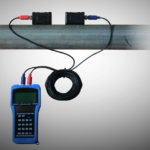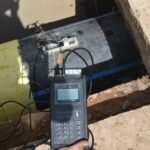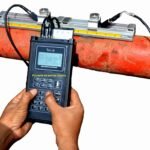Ultrasonic flow meters are commonly applied to measure the velocity of liquids that allow ultrasonic waves to pass, such as water, molten sulfur, cryogenic liquids, and chemicals. Transit time designs are also available to measure gas and vapor flow. Be careful because fluids that do not pass ultrasonic energy, such as many types of slurry, limit the penetration of ultrasonic waves into the fluid. Transit time ultrasonic flow meters can fail to operate when an opaque fluid weakens the ultrasonic wave to such an extent that the wave does not reach the receiver.
The Ultrasonic Transit-time Flow meters work on the principle of measuring the time of flight difference between an ultrasonic pulse sent in the flow direction and an ultrasound pulse sent opposite the flow direction. This time difference is a measure for the average velocity of the fluid along the path of the ultrasound beam. By using the absolute transit time and the distance between the ultrasound transducers, the current speed of flow can be easily found. The Transit-Time based Flow meters are tolerant of liquids with small amount of air bubbles or suspended solids.










